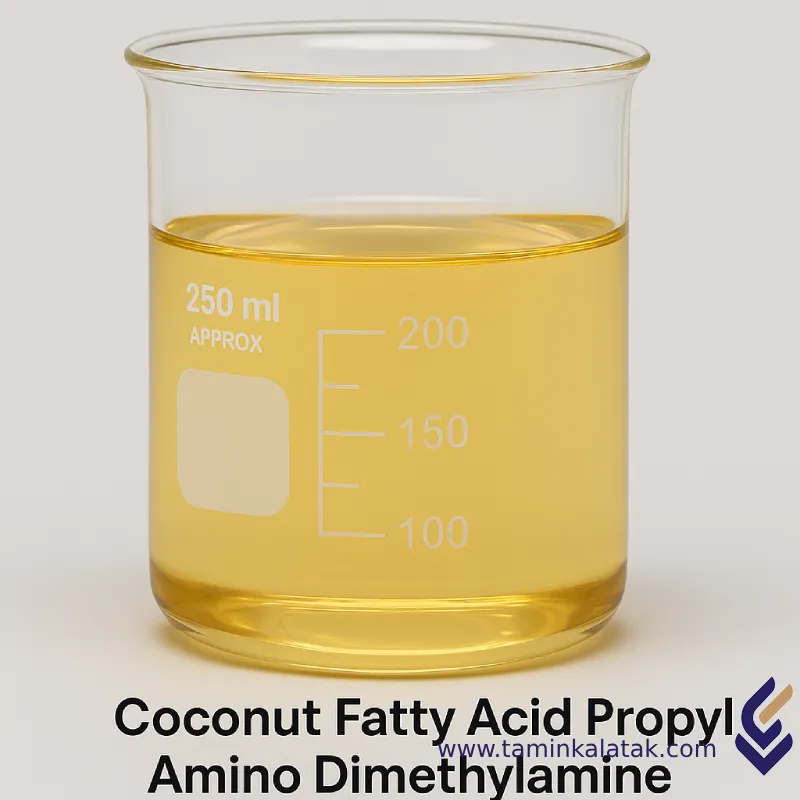Coconut fatty acid propylaminodimethylamine
Coconut Fatty Acid Propylamino Dimethylamine is an amine-based amide derived from the natural fatty acids of coconut oil. In this compound, coconut fatty acid (mainly lauric acid) reacts with dimethylaminopropylamine (DMAPA) to form an amide linkage. It acts as an effective cationic or amphoteric surfactant in formulations for personal care, cleansing, cosmetic, and hair care products.
Chemical Structure
-
Base structure: Coconut fatty acid (C12–C14, primarily lauric acid)
-
Functional group: Propylamino dimethylamine (containing both an amide group and a tertiary amine)
-
Type of bond: Amide linkage between the carboxylic group of the fatty acid and the amine group
-
Structural behavior: In acidic environments, the molecule becomes protonated and carries a positive charge, acting as an effective cationic surfactant. In some formulations, it may also behave as an amphoteric surfactant.
Physical and Chemical Properties
-
Physical state: Clear to pale yellow viscous liquid
-
pH (1% solution): Approximately 9–10
-
Odor: Mild, with a light amine scent
-
Ionic nature: Amphoteric at neutral pH; cationic under acidic conditions
-
Surfactant properties: Yes — moderate foaming ability with excellent conditioning effects
-
Molecular formula: Approx. C17H36N2O (varies depending on fatty acid composition)
Applications of Coconut Fatty Acid Propylamino Dimethylamine
In Shampoos and Conditioners
-
Provides antistatic properties
-
Enhances softness, shine, and combability of hair
-
Compatible with low-pH formulations — ideal for damaged hair
In Body and Facial Cleansers
-
Suitable for sensitive skin
-
Improves foam stability and skin smoothness
In Makeup Removers and Cleansing Products
-
Skin-friendly with low irritation potential
-
Helps emulsify oily residues for better cleansing performance
In Pet Care Products
-
Mild yet effective on animal skin and fur
-
Non-irritating to thin or delicate skin
✅ Advantages
-
Mild and low-irritation: Suitable for sensitive skin
-
Cationic nature: Ideal for hair conditioning and softness
-
Acidic pH compatibility: Superior to typical anionic surfactants
-
Natural origin: Derived from coconut oil
-
Highly biodegradable: Eco-friendly and sustainable
-
Affinity to hair keratin: Forms a smooth, soft film on hair for lasting conditioning
❌ Disadvantages
-
Relatively high cost compared to conventional anionic surfactants
-
Reduced performance in strongly alkaline environments (high pH)
-
Potential for mild skin sensitivity at high concentrations or with frequent exposure
-
Possible contamination with amidoamine (a known irritant) in raw materials, which must be removed during quality control
Applications
| Applications | , , , |
|---|
Coconut fatty acid propylaminodimethylamine
| Products | Chemical formula | CAS number | Grade | Solubility in water | Melting point | Density (at 20°C) | Physical appearance | Vapor pressure |
|---|---|---|---|---|---|---|---|---|
| Cocamidopropyl dimethylamine ، Capramidopropyl dimethylamine | C15H32N2O (according to PubChem for similar derivatives) | 68140‑01‑2 (برای Cocamidopropyl dimethylamine) | Cosmetics, hygiene and industrial | Soluble in water due to the amine group (semi-soluble to soluble) | Liquid at room temperature; melting point for DMAPA ≈ –60 °C | About 0.91–0.94 g/cm³ | Viscous liquid, yellow to light brown | Low – in the range of 0.7–2.4 kPa @ 20–30 °C (similar to DMAPA) |







